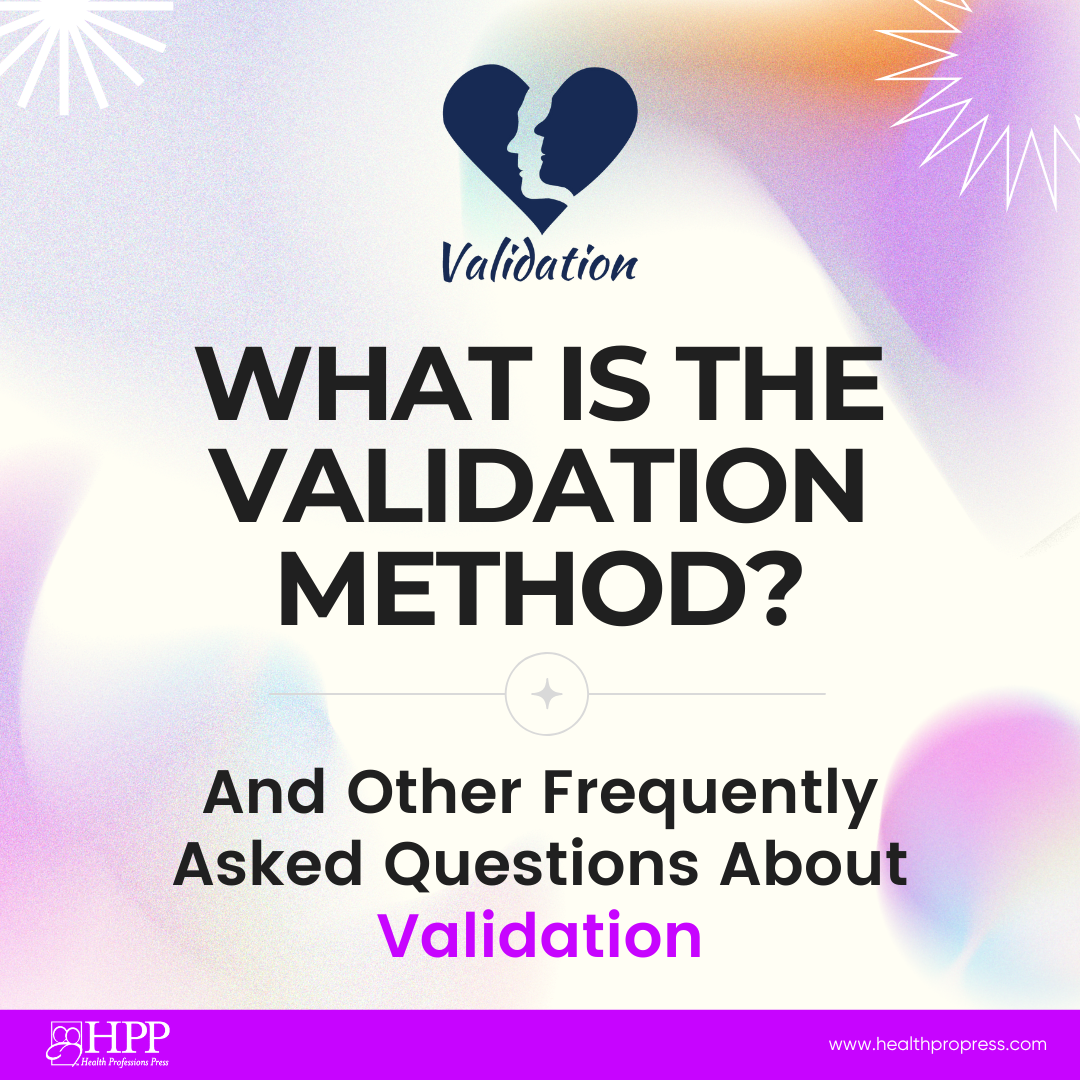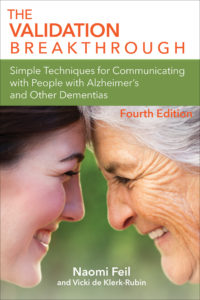
What is the Validation method?
Validation is a method for communicating with older adults who are diagnosed as having Alzheimer’s disease and related dementias. It is based on an attitude of respect and empathy for older adults with Alzheimer’s-type dementia who are struggling to resolve unfinished business before they die. Validation suggests a way of classifying the behaviors of these disoriented older adults and offers simple, practical techniques that help them restore dignity and avoid deteriorating into a vegetative state. Caregivers practicing the Validation method become empathetic listeners, who do not judge the person, but accept their view of reality.
Is Validation a therapy or a method?
Validation is a theory, a method, and an attitude—a theory that very old people need to resolve unfinished issues before death; a method of using verbal and nonverbal helping techniques; and an attitude of respect and empathy for the older adult. Unlike “therapies,” Validation does not give the person insight or try to cure him or her. However, Validation is therapeutic in that it lessens agitation, restores well-being, and maintains communication.
What is Validation made up of?
The Validation method includes 14 techniques across four phases of resolution, based on a set of fundamental, humanistic principles.
What are the 14 techniques of Validation?
Validation consists of 14 techniques that are simple to learn and can be performed over the course of a typical day. These techniques are:
- Centering
- Using Open Questions to Build Trust
- Rephrasing
- Using Polarity
- Imagining the Opposite
- Reminiscing
- Maintaining Genuine, Close Eye Contact
- Using Ambiguity
- Using a Clear, Low, Loving Tone of Voice
- Observing and Matching the Person’s Motions and Emotions (Mirroring)
- Linking the Behavior with Unmet Human Need
- Identifying and Using the Preferred Sense
- Touching
- Using Music
What are the four phases of Resolution in Validation?
In the Validation method, very old people who have ignored or denied the need to address important life tasks in earlier stages of their life enter a period in which they feel the need to resolve unfinished business in order to die in peace. They generally progress through these four phases of Resolution:
- Phase One: Communicating well, mostly oriented; denying, making up stories to cover their losses; energetically and fearfully clinging to what they have not yet lost. The person expresses past conflicts in disguised forms.
- Phase Two: Communicating, mostly living in their personal reality; verbally expressing needs and feelings with new filters.
- Phase Three: Still communicating, mostly internalizing needs and feelings; expressing needs and feelings through movements and sounds.
- Phase Four: Barely perceptible communication; withdrawn and internalizing their needs and feelings.
What are the principles of Validation?
Validation theory and practice are based on the following fundamental, humanistic principles:
- All older adults are unique and worthwhile.
- People should be accepted as they are: we should not try to change them.
- Listening with empathy builds trust, reduces anxiety, and restores dignity.
- Painful feelings that are expressed, acknowledged, and validated by a trusted listener will diminish. Painful feelings that are ignored or suppressed will strengthen.
- There is a reason behind the behavior of people with dementia.
- Early learned behaviors return when verbal ability and recent memory fail.
- Personal symbols used by people with dementia are people or things (in present time) that represent people, things, or concepts from the past that are laden with emotion.
- Disoriented old people live on several levels of awareness, often at the same time.
- When the five senses fail, disoriented older adults stimulate and use their “inner senses.” They see with their “mind’s eye” and hear sounds from the past. Events, emotions, colors, sounds, smells, tastes, and images create emotions, which in turn trigger similar emotions experienced in the past. Older adults react in the present time the same way they did in the past.
Who responds best to Validation?
Validation is most effective with people who have begun to physically and mentally deteriorate in their late 70s or later. Some shared characteristics of people who may benefit from Validation include loss of some recent memory, difficulty walking or sensory impairment, loss of social position or life roles, and often diagnosed with noncommunicable diseases (NCD) due to Alzheimer’s disease.
Validation isn’t the only method or therapy there is. Can I use other methods or therapies?
You can and should. There is no single, foolproof method for communicating with people with dementia. Music, movement, and activities are just a few other helping methods. Validation is just one effective method to learn and use to help disoriented people restore communication and maintain dignity.
I’ve been doing Validation instinctively for years. Why should I take a course to learn it?
You may have the validating attitude—accepting and respecting the old person where he or she is—but to use the techniques, it is vital to learn the Validation method in depth and the principles of Validation in practice. Receiving feedback and supervision makes it possible to really learn the techniques. It is very easy to slip into other methods, and new habits take time to practice and learn.
Our residents feel good here. Can you prove that Validation will help them feel better?
You can use the Validation evaluation form found in The Validation Breakthrough to find out if Validation is restoring well-being. Rate the person from 0 to 4. If, after Validation, the person complains less, communicates more, cries less, smiles more, and so forth, then you know the Validation method is helping. There are also multiple case studies showing some of the research that has been conducted on the effect of Validation on older adults with dementia; on the professionals and paraprofessionals who have cared for them; and on the families of older adults. These case studies demonstrate that positive effects for all three groups have repeatedly been shown.
Validation teaches us “don’t ever lie,” but does that mean pretending to agree with a resident when she says, “My mother is waiting for me?” How do you reconcile these conflicting ideas?
Validation does not mean pretending, agreeing, or disagreeing. When you validate someone, you listen to the person without adding your own reality. You enter into the reality of the person with dementia. You help them express themselves to work through unresolved relationships. In your example, you might say, “What do you need to do for your mother?”
Validation works best with disoriented people over the age of 80. What about with younger people who have Alzheimer’s disease? Is it possible to validate them?
It is possible to use elements of Validation with people who have early-onset Alzheimer’s disease. The validating attitude—using empathy, respect, and honesty—is always a good start for connecting to another person. In the early stages of the disease process, some of the verbal techniques can prove useful.
Where can I learn more about Validation?
You can learn how to use Validation through the books, films, and trainings offered.
Validation products from HPP:
-
- The Validation Breakthrough: Simple Techniques for Communicating with People with Alzheimer’s and Other Dementias, Fourth Edition
- Validation Techniques for Dementia Care: The Family Guide to Improving Communication
- Introduction to Validation: Communicating with Very Old People with Alzheimer’s and Other Dementias (DVD)
Training in Validation
The Validation Training Institute and Authorized Validation Organizations offer a variety of courses in Validation, as well as films and other resources. These learning opportunities can meet the needs of everyone no matter the time and resources available for training.
Training centers are available around the world. Visit the vfvalidation.org for a list of countries where Validation training is offered, as well as the most up-to-date information on training and resources.
Getting started with Validation!

The Validation Breakthrough, Fourth Edition
Simple Techniques for Communicating with People with Alzheimer’s and Other Dementias
By Naomi Feil, M.S.W., ACSW, and Vicki de Klerk-Rubin, R.N., M.B.A.
Copyright © 2022 by Naomi Feil. All rights reserved.
